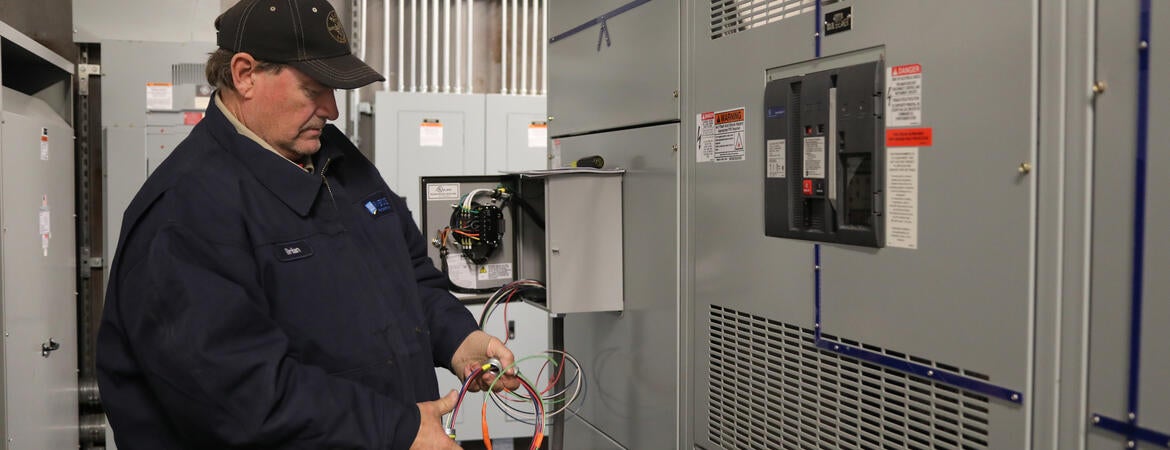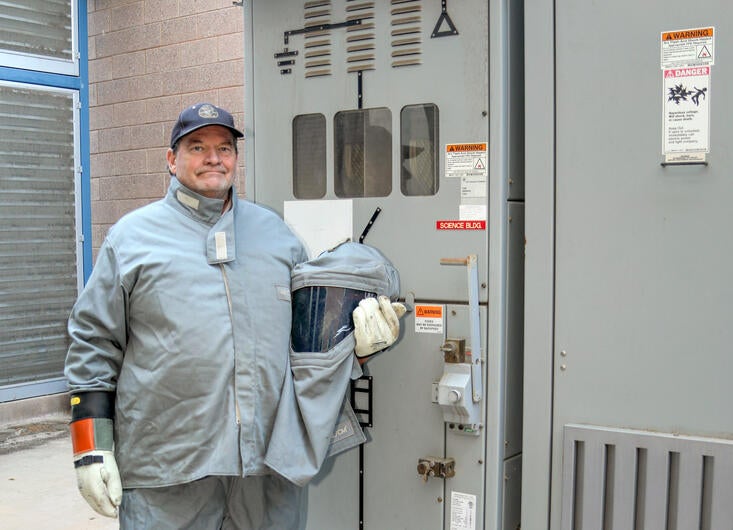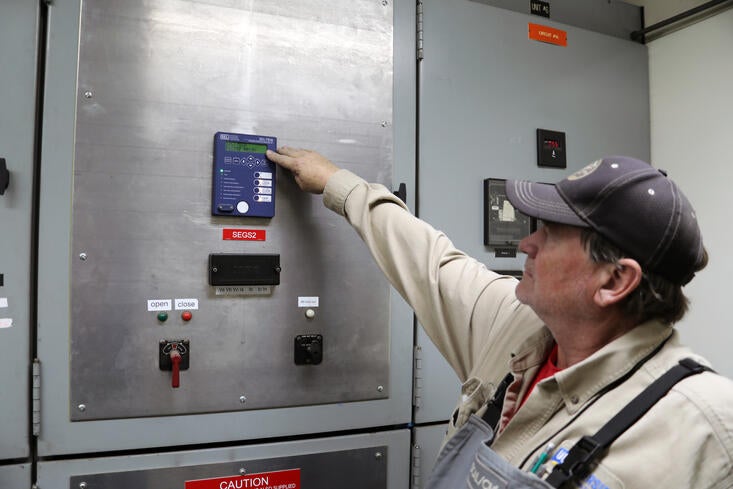
From the Arts Building, to Chemical Sciences, to the Vivaria Trailer, Lead Electrician Brian Hambleton has attentively performed a maintenance checklist of building generators. This included inspecting the generator oil and searching for leaks.
His seamless nanosecond switches from the emergency electrical circuit to generator power are necessary to keep UCR compliant with National Fire Protection Association code 110 testing of the emergency system. For 27 years, Hambleton has been instrumental in keeping the campus's electrical infrastructure not only functioning but improving year after year.
As Electrical Supervisor Kirk Quash will tell, "I've been in the trade for over 40 years, and I can only think of less than five electricians that I remember. Brian I will remember, because of his knowledge and skills base in the field. He's good at high, low, and medium voltage; above and below 600 volts. He can take on just about any job you give him with success, with little or no guidance. A true journeyman. He fits that bill to a tee."
He may be a journeyman today, however, Hambleton originally did not plan to be an electrician but it came naturally to him. His father was an electrician who eventually bought and owned the small electrical company he worked for. In Colorado Springs, Hambleton and his brothers helped his father on the weekends and during the summertime.
Through his father's small business, he gained firsthand knowledge about the electrical industry and grew into the trade. Over the years, Brian and his brothers followed the work, from place to place. After spending some time freezing in Wyoming and finishing a sizable project, they decided to look further south and made a connection for a job in the Golden State.

Southern California is where Hambleton learned his high voltage skills. He and his brothers were willing to adapt and grow. They took on large jobs that others were not willing to do.
"Basically, we were self-taught," Hambleton said. He remembers the day at Norton Air Force Base in San Bernardino when they were given a kit to begin high-voltage work. He was not expecting it, but with guidance they persevered. He went on to take various certification classes through 3M and other manufacturing companies on their high-voltage products.
Hambleton worked on electrical systems for federal projects, prisons, and universities. He changed out transformers across the state including at Marine Corps Base Camp Pendleton, Castle Air Force Base, March Air Reserve Base, San Francisco State University, San Diego State University, the University of California, Los Angeles, and at California State University, Northridge.
He remembers having conversations with the designer of UCR's electrical system 33 years ago in 1990. "I was out here working on the campus changing PCB transformers. In a meeting they said they were going to make big electrical infrastructure loops on campus. I told them that would be great. It would rival any out there," Hambleton said.
Big loops and the strategic placement of switches would permit electric utility to supply buildings in either direction, which is beneficial when a power source fails. Switches could then be opened or closed to bring an alternative power source online. Flexibility within UCR's electrical infrastructure is something Facilities Services and Planning, Design & Construction continues to work on, but it had to start somewhere.
However, when Hambleton became a temporary worker at UCR in 1995, he noticed the plans had not been completed to the level discussed in the meeting. It stopped short due to funding. "I kept asking questions and talking about this idea. Mike Miller, the associate vice chancellor at the time, asked if there was anything I could do with the high-voltage system. That's when we decided to start researching," Hambleton said.
His inspiration came from a switch he was changing out at the University of California, Irvine. It was a section of high voltage owned by Southern California Edison that fed a section of UCI. The new switch had the ability to switch the circuits into itself.
For UCR, he came up with an idea to utilize switches, side by side, an A side and a B side, to acquire the most use of the power. He started installing boxes with four-way switches for both the A and B sides to move from one circuit to another fairly easily without much disruption.
"You can move power either direction around the loop and split it in the middle and work on a section between the loops. You can section parts off and work on sections without losing power. That's the design that is neat. It allows for sections to go down, but it can be switched off to be worked on separately."
Trying to move from the archaic 4160-volt system has been challenging. Making minor adjustments and eliminating old equipment helps to carry the old system forward, at least until further system upgrades can be made. Simplicity seems to drive most decisions when ordering big systems.

Future planning is always on his mind. He keeps large maps to draw up proposals for loops on campus that could activate at different times to aid in maintaining power. In 2017, he worked with Dr. Sadrul Ula from the College of Engineering-Center for Environmental Research & Technology to determine a priority list of deferred electrical projects.
He credits Gerry Bomotti, chief financial officer and vice chancellor for Planning and Budget, for seeing the value in upgrading UCR's electrical system and supporting the deferred projects.
"Brian knows how all of the campus electrical works, and he has been a key asset in working with John Franklin, PD&C project manager, on our primary electric improvements across campus. Brian knows our system so well he can 'engineer' the best solutions for our limited funding to provide the best value to the campus," Bomotti said.
One of the larger projects, which came from an idea formed ten years ago, is almost complete, and will have the capability to open and close all of the circuits on campus using four-way switches remotely from an office. Another project, in another area of campus, will install two more switches that will have a full-automatic mode that can act like a generator, "So if a switch goes down, another switch will go on automatically. It's like fluid. You have to look at the needs of the area," Hambleton said.
When working with others on the electrical system, he said, "We collaborate together, work together, and come up with these ideas. It's a dynamic situation where you learn along the way. Our system is a one-of-a-kind system."
Every day is different for Hambleton. One day he will be working on metering systems. The next day he will be helping the inspection team with high-voltage systems to be installed, helping to design new electrical systems, or taking a call to check something on campus. Hambleton's expertise with high voltage and circuitry is no doubt a rarity.
As Bomotti describes, "He has been 'Mr. Electric' for UCR, for sure. I have seen him dress up in special gear and go into switches in the substation to get power back on for the campus, and do whatever was necessary to help out UCR. Employees like Brian are few and far between overall."
When Hambleton is not in his switchgear suit or sketching electrical designs on campus maps, he can be found on his recently-purchased property in the mountains. He plans to work on the house up there, and repurpose old wood materials for fencing and house building. Using his sawmill, he looks forward to turning his reclaimed wood pieces into something useful.
His efforts and legacy at UCR will be long lasting as the university looks toward the future of electrical reliability, resiliency, and redundancy.